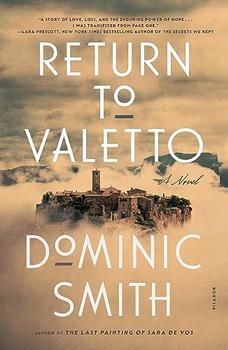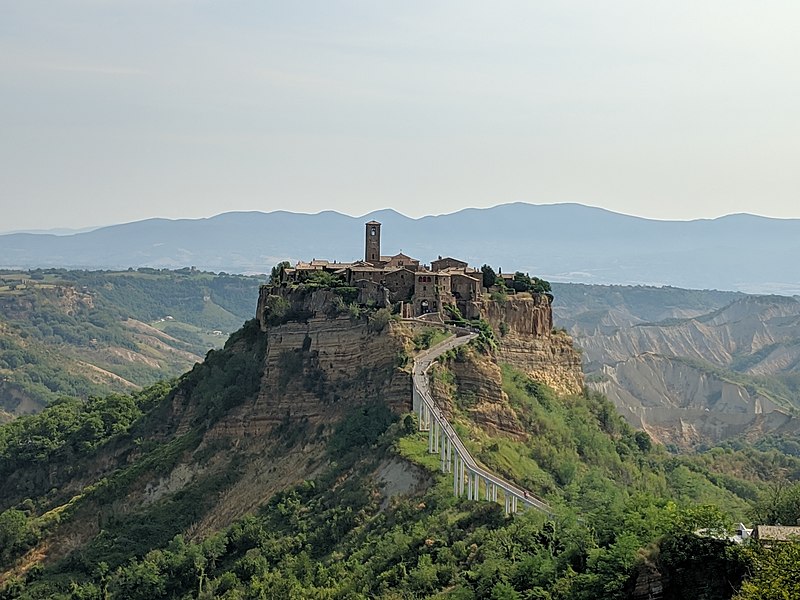Summary | Excerpt | Reviews | Beyond the Book | Read-Alikes | Genres & Themes | Author Bio

A Novel
by Dominic SmithThis article relates to Return to Valetto
 Dominic Smith's novel Return to Valetto was in part inspired by his visit to Civita di Bagnoregio, a town roughly 60 miles north of Rome. Known as "Il paese che muore" or "The Dying City," this tiny village sits atop a crumbling column of clay and tufa (a type of soft volcanic rock common in the region). As the column continues to erode the city's livable area decreases; the village will eventually be destroyed.
Dominic Smith's novel Return to Valetto was in part inspired by his visit to Civita di Bagnoregio, a town roughly 60 miles north of Rome. Known as "Il paese che muore" or "The Dying City," this tiny village sits atop a crumbling column of clay and tufa (a type of soft volcanic rock common in the region). As the column continues to erode the city's livable area decreases; the village will eventually be destroyed.
Civita di Bagnoregio, frequently referred to as just Civita, was founded around 500 BCE by the Etruscans, a civilization that ruled central Italy from approximately the 8th to the 3rd centuries BCE. The city was ideally situated on a towering plateau rising out of a valley between two rivers, the Rio Chiaro and the Rio Torbido. Its height gave it a commanding view of the territory below and protected its residents from floods and malaria that plagued the lowlands. Rio Torbido is a tributary located near the mouth of the Tiber River – a strategically important waterway that provided Civita access to communication and trade. Unfortunately, the ground on which the city was built was unstable. The area was subject to frequent earthquakes and landslides, and the soft sides of the plateau were scoured by wind and rain. The city's earliest residents constructed dams and other water control features in an attempt to minimize erosion, but they also worsened the plateau's stability by digging mines, tombs and tunnels into its base, and quarrying large blocks of tufa from its sides.
Over the ensuing centuries Civita changed hands multiple times. The Etruscans gradually gave way to the Roman Empire, which in turn fell to the Lombards in the 6th century CE. Neither the Romans nor the Lombards paid much attention to the town, and most of the erosion control measures fell into disuse. The area was then ruled by feudal lords until the citizens of Civita di Bagnoregio staged a revolt, becoming a free commune in 1140. This event is commemorated by two carved stone panels inlaid above the city's only remaining gate, the Porta di Santa Maria. Each shows a lion clawing a human head, representing the city's triumph over her oppressors.
People started moving out of Civita as early as the 15th century, creating Bagnoregio, a suburb half a mile away connected to Civita by a land bridge. However, the real exodus began in 1695, when a large chunk of the city on the eastern plateau fell into the valley below during a massive earthquake. The local government and the see of the bishop (the location of a bishop's authority) was moved to Bagnoregio in 1699, sealing the city's fate. By the middle of the 18th century, the population in the disintegrating town had declined to just six residents and a large colony of cats, the emigration exacerbated by continued earthquakes, landslides, and the gradual collapse of the land bridge between Civita and Bagnoregio.
The city never completely died, though, and during the 20th century it began to attract tourists drawn to the area's beauty and history. Civita features remnants of Etruscan habitation, such as the tunnel dug through the rock that completely traverses the town, numerous tombs and other excavations. Its architecture has also largely remained unchanged since the Renaissance and the city boasts some fine examples of medieval structures as well.
Today Civita is accessible only via a long, narrow bridge built in 1965 (residents can use motorcycles or bikes, tourists must travel on foot) for a fee of €5 (~ $5.50 USD). The town, which still has only 12 year-round residents, sees about one million tourists a year. The village is tiny – it takes just five minutes to walk end-to-end – and many feel this unrestricted tourism is having a significant impact on the city's stability. Erosion continues, too, and the city loses about seven centimeters per year; sometimes buildings slide off the edge of the plateau or simply collapse. In 2006 it was placed on the World Monument Watch's list of the 100 Most Endangered Sites.
Distance view of Civita di Bagnoregio. Submitted to the Wiki Loves Monuments Italia 2019 competition.
Filed under Places, Cultures & Identities
![]() This "beyond the book article" relates to Return to Valetto. It originally ran in July 2023 and has been updated for the
June 2024 paperback edition.
Go to magazine.
This "beyond the book article" relates to Return to Valetto. It originally ran in July 2023 and has been updated for the
June 2024 paperback edition.
Go to magazine.




They say that in the end truth will triumph, but it's a lie.
Click Here to find out who said this, as well as discovering other famous literary quotes!
Your guide toexceptional books
BookBrowse seeks out and recommends the best in contemporary fiction and nonfiction—books that not only engage and entertain but also deepen our understanding of ourselves and the world around us.